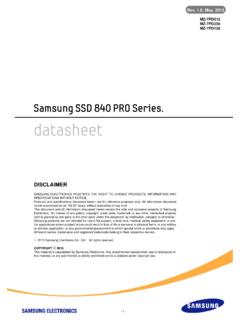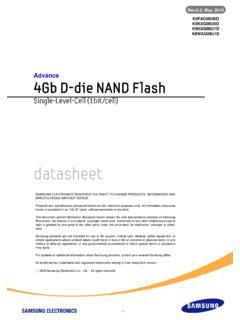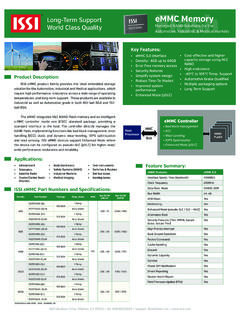Transcription of White Paper Samsung V-NAND technology
1 Samsung V-NAND technologyYield more capacity, performance, endurance and power efficiencyWhite PaperWhite Paper2 Executive summaryThe explosive worldwide growth in data traffic is pushing the limits of nand flash memory . Current 2D planar nand technology has intrinsic limitations, inhibiting capacity expansion without critically compromising performance and reliability. As a result of the inability of 2D planar nand to effectively scale capacity to meet increasing data demands, new solutions must be found. Samsung has developed an innovative solution to satisfy rising data demands with its cutting-edge 3D vertical- nand ( V-NAND ) flash memory technology . By stacking memory cells vertically in a three-dimensional structure, new potential for 3D memory capacities are created, eliminating performance and reliability issues from capacity limitations.
2 Yield superb performance and reliability with Samsung 3D V-NAND flash memoryIn order to keep up with this incredible growth, a new era of flash memory is required at the datacenter level, as well as the client level. nand flash memory is at the core of this process. From the moment the image or video is captured, then sent to the datacenter and, in turn, distributed to the millions or billions of other users, nand flash is part of that infrastructure every step of the 3D V-NAND technology delivers reliable performance at lower costs for today's demanding, data-centric world. This innovative architecture improves memory in the following essential areas: More capacity. Fit more memory cells in a nand chip in less space for significantly more capacity Better performance.
3 Write data much faster by virtually eliminating cell-to-cell interference Outstanding endurance. Experience less stress with insulators more resistant to wear for greater endurance Superb power efficiency. Reduce power consumption by reducing the number of programming stepsThis White Paper explains how Samsung 3D V-NAND flash memory differs from, and is superior to, 2D planar nand trendsRight now the world is experiencing the data explosion era as larger numbers of people and devices connect to the Internet. By some predictions, the exponential growth will likely exceed 50 billion connected devices by data traffic is also booming, growing in staggering numbers with more connections, faster speeds, more videos and more users. Social media is largely responsible for this astounding and social networking have turned everyone from content consumers to content creators.
4 To put this growth into perspective, more videos are uploaded to YouTube in one month than were created by the three major networks in sixty years. WhatsApp handles 50 billion messages per day, Twitter experiences more than 500 million tweets per day and mobile phones are checked 100 billion times a day. On average, in 2014, billion photos are uploaded a day. More than 100 million selfies alone are shared every day and, when they go viral, they are causing IT challenges in moving the data around. In total, social networking activities account for 91 percent of mobile data today's data demands with Samsung 's revolutionary3D V-NAND technologyFigurine 1: Social media comprises 91 percent of mobile Internet AreaWhite Paper3 Discover the advantages of V-NAND compared with planar NANDThe architectural changes that have been made to Samsung V-NAND flash memory in comparison to planar nand include tripling the number of pages and the block size.
5 In addition, dual-page programming has been adopted to improve the program bandwidth, as well as reduce strong electron correlation effects and bit addition, the 1st Generation V-NAND technology has increased the capacity in the unit size to twice that of 21nm planar nand . Improvements also include 24-Word Line (WL) stacked layers, 64Gb array in multiples of two planes, a one-sided page buffer equaling an 8 KBx2 page size and an asynchronous double data rate (DDR) interface at a speed of 533 megabits per second (Mbps) using eight-stacked the limitations of patterning with vertical architectureIn an effort to shrink cells to fit more cells in less space in 2D planar nand flash memory , it becomes difficult or impossible for light to penetrate the mask to transfer the pattern to a photoresist.
6 The reduction in light constricts the patterning process or prevents the process from taking place. This inherit obstacle limits the use of 2D planar nand flash memory in today's demanding memory , Samsung 's 3D V-NAND design stacks cells vertically, resulting in a wider gap between each cell, overcoming patterning limitations. The cell-to-cell space in a planar 1 Ynm nand typically ranges from 15 nanometers (nm) to 16nm, but Samsung V-NAND flash has 30nm to 40nm of space between cells, creating a nand technology beyond traditional planar nand capacity with an advancedcell-stacking configurationFeatures21nm planar 64 GbV1 128 GbVoltage Supply (Typ)VCC: , VCCQ: : , VCCQ: onlyPage Size within a Block(8K+640) Bytes(8K+896) BytesNumber of Pages per Block128 Pages384 PagesBlock Size(1M+80K) Bytes(3M+336K) BytesNumber of Planes42 Page Program per Plane(8K+640) Bytes2 x (8K+896) Bytes1 Page Program Time (tPROG) Read per Plane(8K+640) Bytes(8K+896) BytesRandom Read Time (tR)252 s49 sDate Transfer Rate400 Mbps533 MbpsBlock Erase Time (tBERS)5ms4msTable 1.
7 Key features of the 35K V-NAND flash memory versus the 10K planar flash memoryNote 1. Dual page program / Note 2. 8KB read caseFigure 2. A die microphotograph of a 1st Generation 128Gb 2bit memoryFigure 4. A bird's-eye view of the V-NAND structureFigure 3. The V-NAND design widens the gap between cells to overcome patterning limitations and cross Paper4 Another technical challenge that arises from continually shrinking cells in 2D planar nand technology is the creation of cell-to-cell interference, which leads to data when a cell size goes below 20nm, the chance for interference drastically increases, inevitably making the cell unreliable. Samsung has addressed that issue by adopting Charge Trap flash (CTF) technology that results in a cell-to-cell interference-free superior cell characteristics with advanced CTF technologySamsung s revolutionary 3D V-NAND technology features a unique design that stacks 24 layers of cells on top of one another instead of trying to decrease the cells' length and width to fit into today's ever-shrinking form factors.
8 Using this new 3D V-NAND architecture creates two times the density of a traditional 2D planar nand in a smaller innovative design eliminates pattern limitations while achieving a much larger scalable capacity to satisfy present and future data demands. 3D V-NAND s unique design is achieved by disruptive innovation of material, structure and planar nand memory , the cell stores the electron in the conductor. With V-NAND memory , the conductor is replaced by an insulator, which has a lower height and, thereby lowers the coupling. In addition, the V-NAND memory has a larger channel area than planar nand memory , which improves the initial electron dispersion, creating an almost coupling-free cell cell density with a smaller footprint and innovativematerial and structureControl GateFloatingGateConductorControlGateSSub strate-SiSi ChannelInsulatorDSSubstrate-SiDInsulator (Trap Site)ChannelOxiderHChannel Area :2 rH >> F 2F Planar V-NAND33% 3D V-NAND3D V-NAND1xnmNAND1xnm NAND84% Normalized( )# of CellsVth ( )Natural VthDistributionCellCouplingInitial Vth After CouplingFigure 6.
9 Cell characteristics of the V-NAND versus planar nand memoryFigure 5. The V-NAND cell-to-cell interference-free structure Cell to Cell Interference B/L Interference Free W/L Interference Almost Free Patterning Patterning Issue FreeWord LineBit LineWhite Paper5 Material innovation Using advanced CTF technology , Samsung 's 3D V-NAND flash memory boasts a cell-to-cell interference-free structure. CTF technology uses a non-conductive layer of silicon nitride (SiN), which temporarily traps electrical charges to maintain cell integrity. This non-conductive layer is modified into a three-dimensional form to wrap around the control gate of the cell, acting as an insulator that holds charges to prevent data cor-ruption caused by cell-to-cell cross innovation and integration To create the vertical integration of 3D V-NAND cell layers, Channel Hole technology is used.
10 This technology enables cells to connect vertically with one another through a cylindrical channel that runs through each column of stacked cells and ro-tates 90 degrees. The 24-layer stacks of cells are connected to over 2 billion channel holes that are etched from the top layer of the nand to the bottom layer. Looking from a top-down view, all the holes can be seen on a 128Gb nand chip that is the size of a fingernail. The cylindrical channels enable seamless integration of the vertical layers of compatibility issues with planar nand flash memoryAs stated earlier, Samsung 3D V-NAND flash memory is composed of vertically stacked cell strings as opposed to planar nand , which is arranged in a cell string on a single plane. Although the architecture is quite different, the Samsung V-NAND flash memory page operation is compatible with existing planar flash .















